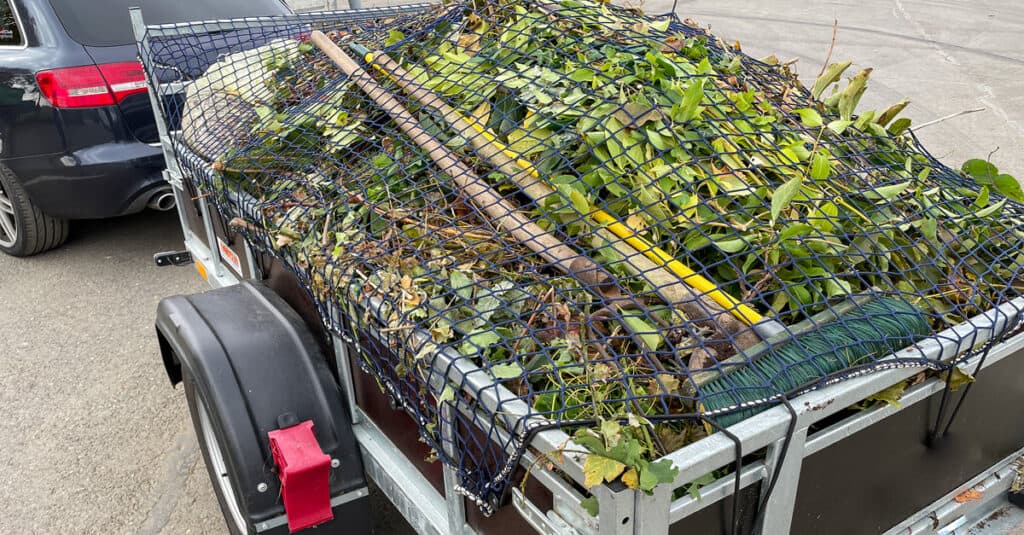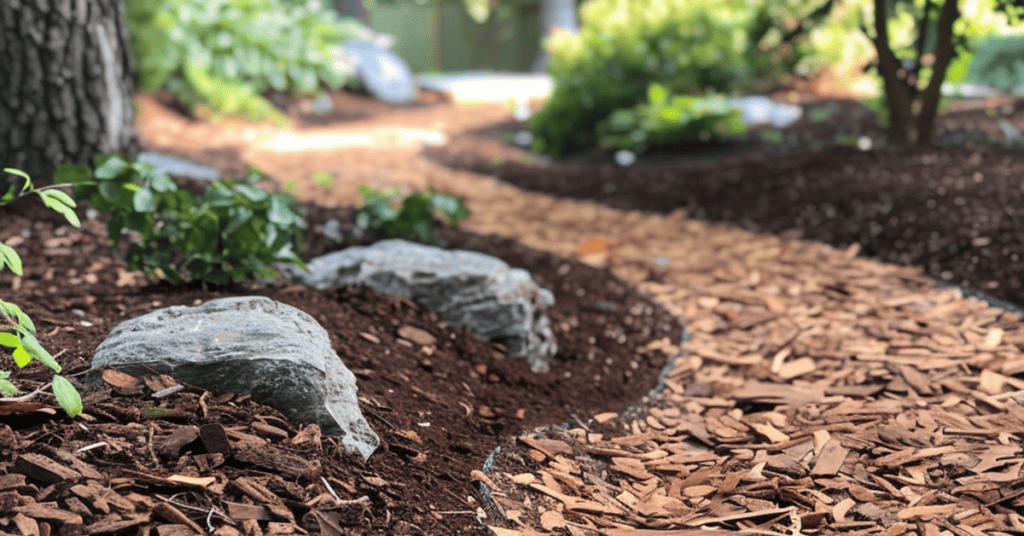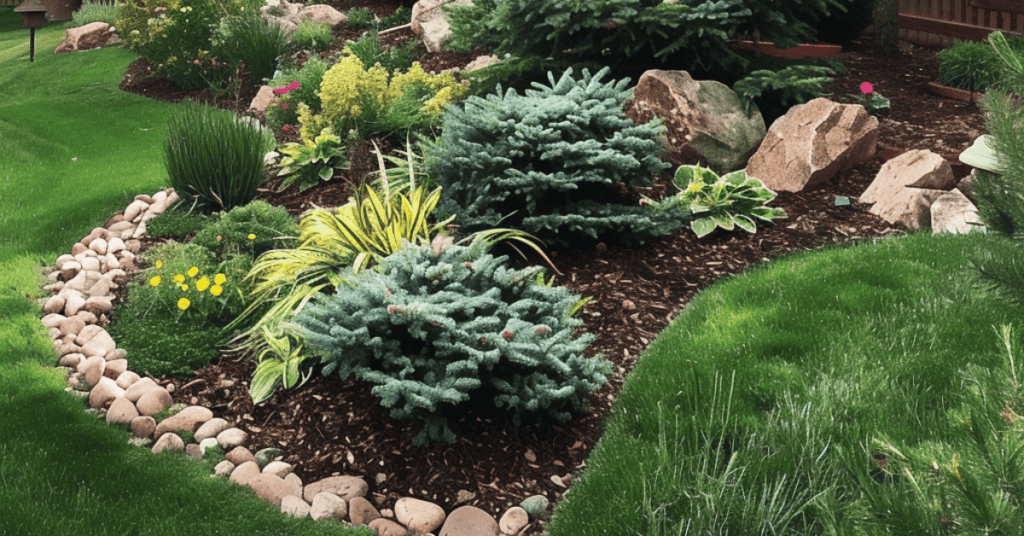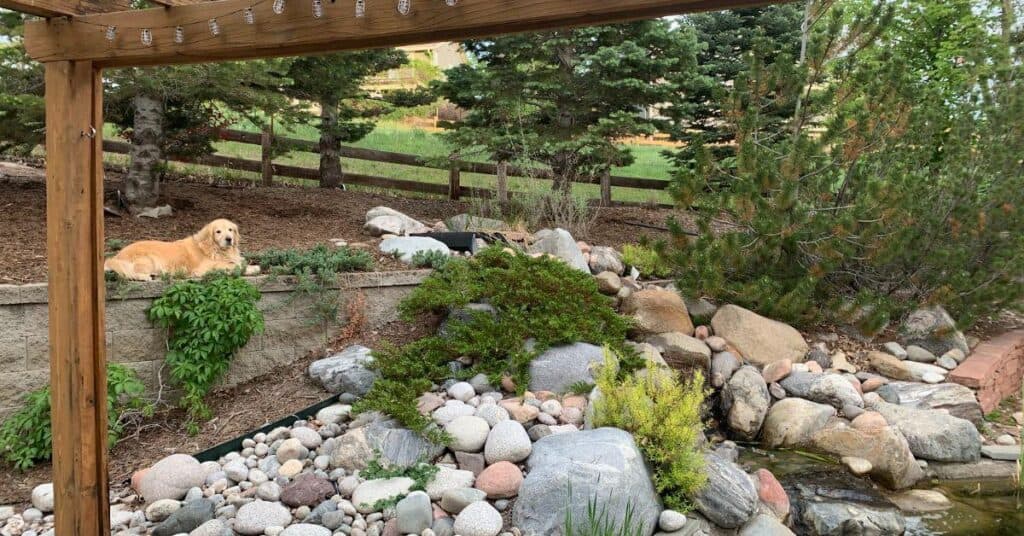Good Drainage and Weed Suppression from Pea Gravel
Pea gravel is a popular choice for landscaping due to its small, smooth stones and versatile applications. These stones typically measure 1/8 to 3/8 inches and are rounded, making them easy to walk on and handle.
The natural colors of pea gravel give homeowners a range of options. Colorful pea gravel comes in shades of gray, white, tan, and brown. You should be able to find the perfect color to meet your landscape design requirements.
Uses of Pea Gravel in Landscaping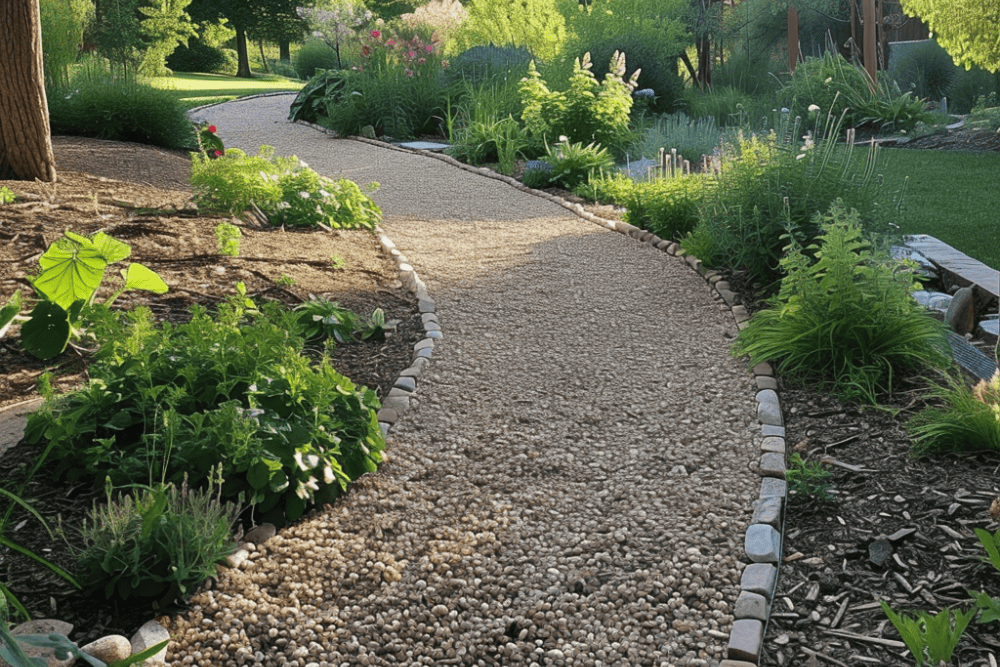
Pea Gravel Walkways Generally Have Earth Tones Ranging From White to Brown
- Pathways: Ideal for creating smooth, visually appealing walkways.
- Patios: Provides a rustic, natural look for outdoor seating areas.
- Garden Borders: Adds definition to flower beds and garden borders.
- Playground Surfacing: Safe and clean surface for children to play on.
Design Applications
Patio Construction and Decor
Pea gravel is a popular choice for patios. It provides a flexible and well-drained base, making it an excellent alternative to concrete or brick. Creating a pea gravel patio involves removing about six inches of soil, adding edging to contain the gravel, and applying layers of landscaping fabric and base rock. Finally, the pea gravel is spread and tamped down for an even, stable surface.
This type of patio blends well with natural surroundings and offers a soft, textured surface. It can be enhanced with potted plants, outdoor furniture, and decorative stones, creating a cozy and inviting outdoor living area.
Functional Pathways and Walkways
Pea gravel is an ideal material for creating pathways and walkways. Its small size and rounded shape make it comfortable to walk on, and its porous nature ensures good drainage, reducing puddles and mud. To build a walkway, a layer of landscaping fabric is placed to prevent weed growth, followed by a base layer of rough-textured rock, then a top layer of pea gravel.
These walkways offer a stable, durable surface that is less labor-intensive to install than paved paths. They can be lined with edging or decorative stones to keep the gravel in place and to add a finished look. 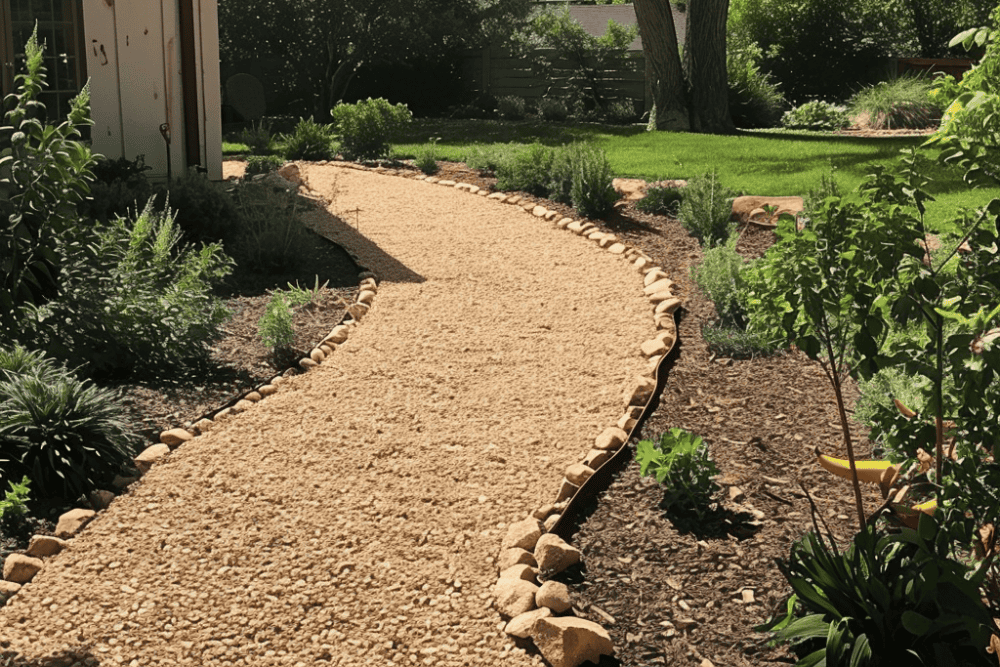
A Pea Gravel Path With Landscaping Fabric Underneath Will Drain Well and Should be Largely Free of Unwanted Weeds
Practical Benefits
Enhanced Drainage Solutions
Pea gravel is a popular choice for managing drainage issues in landscaping. Its small, rounded stones allow water to flow through easily, rather than pooling on the surface. This reduces the risk of erosion and helps maintain soil health.
Using pea gravel in walkways and around foundations can divert water away from structures. This is especially useful in areas prone to flooding or heavy rainfall. Its ability to improve drainage makes pea gravel ideal for pathways, patios, and garden beds.
Weed Suppression
Pea gravel is also effective in controlling weed growth. When used correctly, it can form a barrier that minimizes the chances of weeds sprouting. Spreading a layer of pea gravel on top of landscaping fabric can significantly enhance this effect.
The fabric acts as a physical barrier, while the gravel cuts off light access to weeds. This double layer suppresses weed growth efficiently. It’s a practical, long-term solution for maintaining clean and tidy garden areas.
Ease of Maintenance and Upkeep
One of the standout qualities of pea gravel is its low maintenance. Once installed, it requires minimal upkeep compared to other materials like mulch or sod. Its durability means it doesn’t need frequent replacement.
Installation Techniques
Installing pea gravel involves careful preparation and layering to ensure a stable and durable surface. Proper installation makes maintenance easier and enhances the overall look of the landscape.
Preparing the Landscape Foundation
Start by removing the soil from the area to a depth of six inches. This helps in creating a stable base. After excavating, install edging materials like metal or wood borders to prevent gravel from spreading.
Next, lay down landscape fabric at the foundation. This fabric acts as a barrier, stopping weed growth and keeping the gravel clean. Secure the fabric with landscape pins to hold it in place.
A two-inch layer of crushed stone base rock is then added on top of the fabric. This base rock, with its rough texture, provides added stability. Using a tamper or plate compactor, compact this layer until it’s level and firm.
Layering and Depth Optimization
Over the base rock, spread a three-inch layer of pea gravel evenly. The gravel should be towards the larger end of the size spectrum for pea gravel – about 3/8 inch in diameter for optimal use in pathways and patios.
Make sure to distribute the gravel uniformly to avoid any hollows or peaks. Using a garden rake can help achieve a smooth surface. Tamping the gravel lightly with a tamper will help in settling it firmly into place.
For areas with heavier foot traffic, consider adding another inch of pea gravel to reinforce the surface. Consistently check and adjust to maintain the desired depth and evenness.
Material Characteristics
Pea gravel boasts various features that make it a popular choice in landscaping. Key attributes include its size, shape, texture, and an array of color options to suit different aesthetic preferences.
Size, Shape, and Texture Variances
As mentioned, with a size between ⅛ and ⅜ of an inch, pea stones have a smooth, rounded shape due to natural weathering processes. They’re actually quite comfortable to walk on and easy to work with.
Textures vary slightly based on the type of stone. For example, granite pea gravel might feel a bit rougher compared to the smoother surface of river stones. This texture can affect the material’s uses, such as footpaths or playground areas. Understanding these differences helps in selecting the appropriate type for specific landscaping tasks.
Color Selection and Matching
One of the appealing aspects of pea gravel is its diverse color range. The stones come in a variety of hues including white, tan, brown, gray, and in some cases even shades of blue and red. Each color can complement different types of plants, outdoor furniture, and other landscape elements.
Choosing the right color involves considering the overall design theme. For instance, a modern garden might benefit from sleek, gray stones, while a rustic yard could look more inviting with earth-toned gravel. Matching the gravel color to the surrounding elements can enhance the visual harmony of the landscape.
Pea Gravel Cost
Pea gravel is a cost-effective material. For example, bulk pea gravel costs about $45-$90 per cubic yard. Even with bulk pea gravel delivery fees, you should expect to pay significantly more on a cubic yard basis for bagged pea gravel from your local hardware store. If you need a large amount of pea gravel for your landscaping project, you should attempt to buy in bulk if at all possible.
Complementary Materials
Using pea gravel in landscaping often involves combining it with other materials. This enhances the aesthetic appeal and functional value of the landscape. Key materials like pavers, different types of small stones, rocks, boulders, and other edging material should work well together.
Combining with Pavers and Stepping Stones
Pea gravel pairs well with pavers and stepping stones. This combination creates sturdy walkways that blend natural beauty with practicality. Concrete, or brick pavers provide a solid walking surface, while pea gravel fills the gaps, adding texture and drainage.
Flagstone and crushed stone are other options that can be used with pea gravel in stepping stone paths. These stones contrast nicely with the small, rounded stones, creating a visually appealing path. The use of river rock can add variety and interest to the design.
Mixing with Other Gravel Types
Different gravel types can be mixed with pea gravel to create unique landscaping looks. Crushed rock, with its sharp-edged stones, offers a contrasting texture when mixed with smoother pea gravel.
Combining pea gravel with larger stones like river rock or crushed gravel can also help with drainage and stability. For areas that need extra support, such as driveways or heavy-use paths, the mix of these materials can be very effective. Cement or concrete can be used to stabilize sections, preventing the shifting of materials.
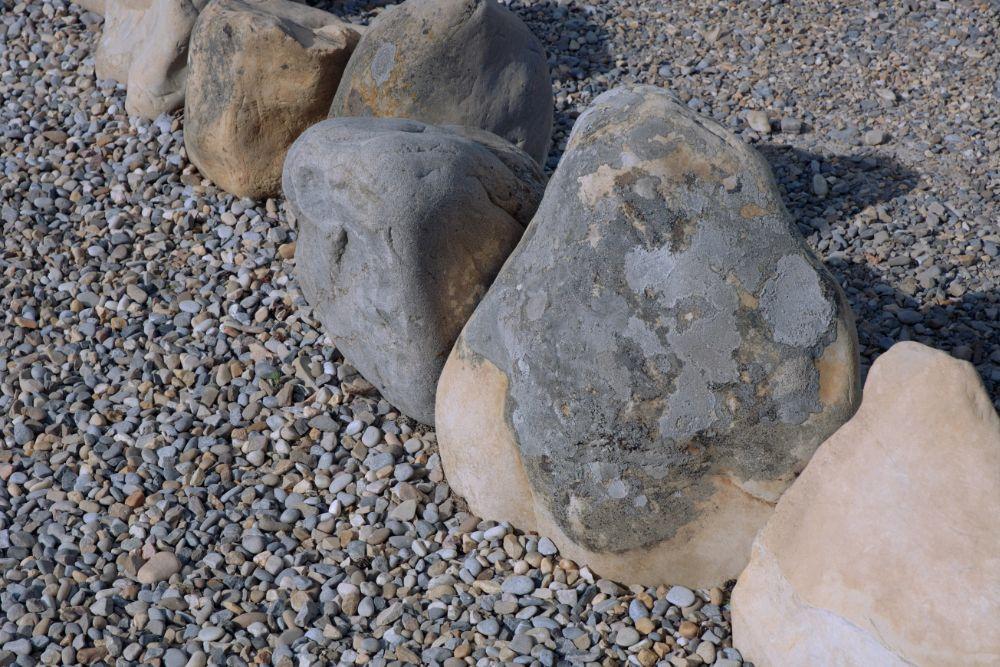
Combining Pea Gravel with Large Rocks for Borders
Utilizing Edging Materials for Definition
Edging materials are crucial for keeping pea gravel in place. Concrete, wood, or metal edges define the area, preventing the gravel from spreading out. Brick is another timeless option that adds a classic look to the landscape.
Using landscape fabric underneath the gravel can further control weed growth and keep the gravel layer intact. The combination of edging and landscaping fabric ensures that the pea gravel remains where it is intended, maintaining a neat and organized appearance for longer.
Specialty Utilizations
Pea gravel offers unique options for incorporating it into various landscaping designs. It enhances aesthetics and functionality in creative ways, making it a versatile hardscaping material.
Landscape Lighting Integration
Pea gravel can play a crucial role in integrating landscape lighting. By embedding landscape lights within areas filled with pea gravel, it allows for more flexibility and safety. This ensures that the lights are protected from lawn equipment and foot traffic. It also creates a seamless and polished look between the lighting and the surrounding landscape. The gravel provides a stable base, preventing lights from shifting or tilting.
Creating Rustic or Classic Looks
For those aiming to achieve a rustic or classic aesthetic, pea gravel offers a natural, timeless appearance. It complements wooden patio furniture and aged stone features, making it an ideal choice for garden paths and seating areas. When used around a fire pit, it provides both aesthetics and safety by preventing the spread of flames to surrounding greenery. This helps in seamlessly blending modern comforts with traditional landscape elements.
Innovative Uses in Hardscaping
In hardscaping, pea gravel can be used creatively in conjunction with other materials like stepping stones, stone slabs, and pavers. Its small size and uniform texture work well in filling gaps between larger stones, ensuring stability while adding visual interest. It is also often used to line garden beds or as a base for a patio, providing excellent drainage and weed prevention. This versatility makes it a popular choice for both functional and decorative hardscaping projects.
